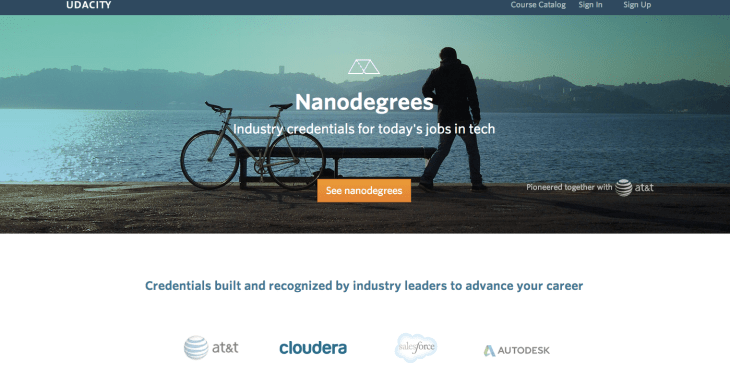As its push to transform education through technology begins to show results, massively open online course provider Udacity is announcing a fresh $35 million financing from a global group of investors to take its vision worldwide.
Earlier this year the company launched its nanodegree program through a partnership with AT&T, a collaboration that intends to train would-be programmers in a specific skillset that ostensibly would qualify them for a job in the field.
It’s the first fruit from Udacity’s Open Education Alliance, a consortium of businesses which have agreed to recognize an industry-focused skills credential, which chief executive and company founder Sebastian Thrun discussed at our Disrupt conference last year.
As it looks to roll out more nanodegree programs to students around the world, the company has lined up investment partners from Brazil, Japan, Germany and the U.S. heartland to help it expand. Drive Capital, the Columbus, Ohio-based venture firm founded by two Sequoia Capital partners, led the round, and the firm’s founder (and Thrun’s longtime friend) Mark Kvamme will take a seat on the company’s board.
In addition, the German media giant, Bertelsmann, Japanese staffing company Recruit, Brazilian investment firm Valor Capital Group, and American cable and media company Cox Enterprises, also joined as new investors. Previous backers Andreessen Horowitz, Charles River Ventures, Peter Levine, and George Zachary also participated in the financing.
“The way we’re doing this, our education is really built by industry,” says Thrun. “They give us their best staff, they give us money to build the content, and they really take a first-hand design of the curriculum. [For isntance] Google built with us Android classes that define what an Android programmer should know, according to Google.”
Udacity has been excoriated by academics, who fret that the company’s emphasis on vocational training could replace the liberal arts degree as debt-saddled students opt for cheaper (and ostensibly faster) paths to a career than spending four years in an ivory tower.
Thrun’s response is that Udacity is not meant to replace four-year degrees but supplement them. And some grounding in computer programming is essential before a student can enroll in one of its nano-degree programs.
“We are distinctly not in the college space,” says Thrun. “We’re in the young professional space. We don’t see ourselves as an augmentation of colleges, or a competitor. Rather we are how young professionals stay skilled enough to remain employable.”
The typical Udacity student is between 24- and 34-years-old, and is currently “under-employed”, according to Thrun. Unlike development bootcamps or other software training programs, which require significant time commitments with an intensive daily curriculum, Udacity and its cohort of MOOCs are meant for engagement at a user’s own pace.
Although AT&T is currently the only company to offer a nanodegree, Thrun says that there are 20 partners who will roll out courses on the platform, and a typical student will receive certification for their work within six months to a year. At $200 per month, that’s far cheaper than a Computer Science degree from Stanford or MIT, and since companies are committing to consider nanodegree recipients for positions, it’s a pretty good network for job-seekers.
As soon as the program was announced, Thrun said Udacity was flooded with 50,000 emails expressing interest. Through its original curriculum the company already has close to three million enrollments from 119 countries for its classes.
With its capital raise and the launch of the program, Thrun’s Udacity hopes to regain some of the luster that it lost when it rolled out its initial efforts in conjunction with universities and an especially a rocky 2013.
“We were working with academia and our work was not as well received as I’d hoped,” says Thrun. “But we wanted to reinvent education and we believe bringing education back to companies is a good move for society.”
Kvamme, the founder of Drive Capital, agrees. From his perch in Ohio, Kvamme says executives are in Drive’s offices all the time, bemoaning the lack of good programming talent and the need for skilled employees that crosses every industry from manufacturing, to retail, to software development companies themselves.
“The whole time where you get four to eight years of education and after that you’re done getting educated — those days are soon ending,” Kvamme says. “You need to have a methodology and a curriculum that helps you stay current.”
